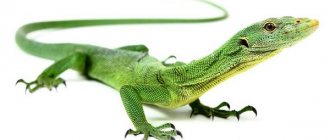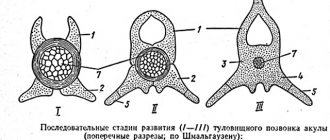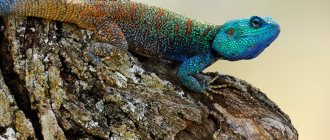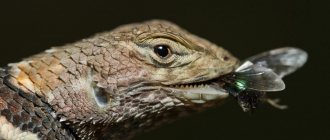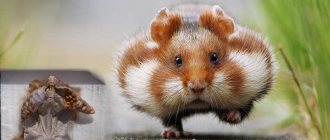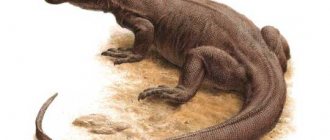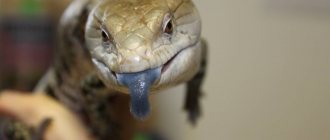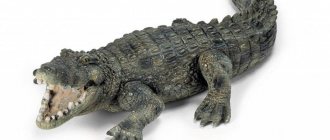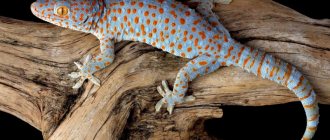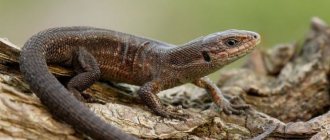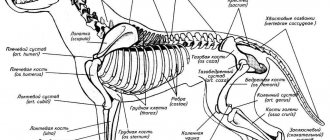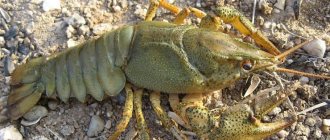The squat body of the lizard is characterized by a flattened, pointed head, delimited from the body by a well-defined constriction of the neck. The mouth is very wide. There are two eyes on the sides of the head; each eye is equipped with an upper and lower movable eyelid and a transparent nictitating membrane extending from the anterior corner of the eye; it may pull the eyeball from front to back. Behind the eye on each side there is a rounded brown spot of skin—the eardrum, located below the general level of the skin. Short limbs: five-fingered; the first toes are shorter than the others (both on the front and hind limbs). The long body is convex on the back and sharply flattened on the belly. At the root of the tail, a transverse slit-like opening of the cloaca is clearly visible. The tail is cylindrical, thick at the base and gradually thinning towards the end.
Interesting facts about lizards
Lizards are amazing creatures, which are distinguished from other representatives of the fauna by several interesting facts. The first fact is the size of representatives of different lizard populations. For example, the smallest lizard, Brookesia Micra, is only 28 mm long, while the largest representative of this group of reptiles, the Indonesian monitor lizard, also known as the Komodo dragon, has a body length exceeding 3 meters, weighing about one and a half quintals.
The second fact that makes these reptiles popular not only among biologists, but also among ordinary people is why and how the lizard casts its tail. This ability is called autotomy and is a method of self-preservation. When a lizard runs away from a predator, it can grab it by the tail, which actually poses a threat to the life of the reptile. In order to save their lives, some species of small lizards are able to shed their tail, which grows back after some time. To avoid large blood loss during autotomy, the tail of the lizard is equipped with a special group of muscles that contract blood vessels.
In addition to everything listed above, lizards in nature have the quality of skillful camouflage, adapting to the color scheme of the environment. And some of them, especially the chameleon, can take on the color of a neighboring object in a matter of moments. How does this happen? The fact is that the skin cells of a chameleon, consisting of several almost transparent layers, have special processes and pigment, which under the influence of nerve impulses can shrink or unclench. At the moment the process contracts, the pigment gathers in the center of the cell and becomes barely noticeable, and when the process unclenches, the pigment spreads throughout the cell, coloring the skin a certain color.
Development
A fertilized egg is a large spherical yolk with a spot of an embryo on it. Descending along the oviduct, the egg is surrounded by egg membranes, of which in reptiles the parchment membrane is the most pronounced. It replaces the mucous membrane of amphibian eggs and protects the egg from external influences on land.
In May - June, the female lays 6-16 eggs in a shallow hole or burrow. The eggs are covered with a soft, fibrous, leathery shell that protects them from drying out. Eggs have a lot of yolk, the white shell is poorly developed. Already at the beginning of the development of the embryo, an extraembryonic bubble is formed from its tissues, which gradually surrounds the embryo on all sides. The embryo, along with the yolk, is suspended inside the egg. The outer shell of the bladder - serosa - creates antimicrobial protection. The inner membrane - the amnion - limits the amniotic cavity, which is filled with fluid. It replaces the embryo with a pool of water: it protects against tremors.
Cut off from the outside world, the fetus could suffocate and be poisoned by its own secretions. These problems are solved by another bladder - the allantois, which is formed from the hindgut and grows into the first bladder. Allantois accepts and isolates all the products of the embryo's excretion, and returns water back. Blood vessels develop in the walls of the allantois, which approach the surface of the egg and ensure the exchange of gases through the membranes of the egg. Thus, the allantois simultaneously plays the role of an embryonic organ of excretion and respiration. All development takes place over 50-60 days, after which the young lizard hatches. The young cub is ready to live on land. It differs from an adult only in its smaller size and underdeveloped reproductive system.
Skeleton and internal structure of a lizard
The body of a lizard consists of parts such as head, neck, torso, tail and limbs. The body on the outside is covered with scales, consisting of smaller and softer horny formations compared to fish scales; there are no sweat glands on the skin. A characteristic feature is also a long muscular organ - the tongue, which is involved in feeling objects. The eyes of a lizard, unlike other reptiles, are equipped with a movable eyelid. The muscles are more developed than those of reptiles.
The lizard's skeleton also has some features. It consists of the cervical, shoulder, lumbar and pelvic sections, which are connected by the spine. The skeleton of a lizard is built in such a way that, when fused, the ribs (the first five) form a closed sternum from below, which is a characteristic feature of this group of reptiles compared to other reptiles. The chest performs a protective function, reducing the risk of mechanical damage to internal organs, and it can also increase in volume during breathing. The limbs of the lizard, like those of other terrestrial vertebrates, are five-fingered, but unlike amphibians they are located in a more vertical position, which ensures some elevation of the body above the ground and, as a result, faster movement. The long claws with which the reptile's paws are equipped also provide significant assistance in movement. In some species they are especially tenacious and help their owner to deftly climb trees and rocky terrain.
The lizard skeleton differs from other groups of terrestrial fauna in the presence of only 2 vertebrae in the sacral spine. Also a distinctive feature is the unique structure of the caudal vertebrae, namely in the non-ossifying layer between them, thanks to which the lizard’s tail is painlessly torn off.
Organ systems
Respiratory
Breathing is only pulmonary. The breathing mechanism is of the suction type (breathing occurs by changing the volume of the chest), more advanced than that of amphibians. Conducting airways (larynx, trachea, bronchi) are developed. The inner walls and septa of the lungs have a cellular structure.
Blood
The heart is three-chambered, consisting of two atria and one ventricle. The ventricle has an incomplete septum. The systemic and pulmonary circulations are not completely separated, but the venous and arterial flows are more clearly separated, so the body of reptiles is supplied with more oxygenated blood.
The right atrium receives venous blood from all organs of the body, and the left atrium receives arterial blood from the lungs. When the ventricle contracts, its incomplete septum reaches the dorsal wall and separates the right and left halves. From the left half of the ventricle, arterial blood enters the vessels of the brain and the anterior part of the body; from the right half, venous blood goes to the pulmonary artery and further to the lungs. The trunk region receives mixed blood from both halves of the ventricle.
Nervous
The brain is more developed, especially the forebrain hemispheres (responsible for complex instincts), the optic lobes and the cerebellum (coordinator of movements).
What are the similarities between a lizard and a newt?
Some people confuse lizards with newts - representatives of the infraorder of tailed amphibians. What are the similarities between a lizard and a newt? Representatives of these two superclasses are similar to each other only in appearance; the internal structure of newts corresponds to the anatomy of amphibians. However, from a physiological point of view, both lizards and newts visually look the same: a snake-like head, movable eyelids on the eyes, a long body with five-fingered limbs on the sides and sometimes with a crest on the back, a tail capable of regeneration.
Lizard food
The lizard is a cold-blooded animal, that is, its body temperature changes depending on the ambient temperature, so these reptiles are most active during the day, when the air warms up the most. Most of them are carnivorous lizards, the species and names of which include more than one thousand individuals. The prey of lizard predators directly depends on the size of the reptile itself. Thus, small and medium-sized individuals feed on all sorts of invertebrate animals, such as insects, spiders, worms, and mollusks. The prey of large lizards are small vertebrates (frogs, snakes, small birds or lizards). The exception is the Komodo dragon, which, due to its large size, can afford to hunt larger game (deer, pigs and even medium-sized buffalo).
Another part of the lizards are herbivores, eating leaves, shoots and other vegetation. However, there are also omnivorous species, such as Madagascar geckos, which eat plant foods (fruits, nectar) along with insects.
Regeneration
Various birds, small animals and snakes feed on lizards. If the pursuer manages to grab the lizard by the tail, then part of it is thrown away, which saves it from death.
Throwing the tail is a reflex response to pain; it is carried out by breaking one of the vertebrae in the middle. The muscles around the wound contract and there is no bleeding. Later, the tail grows back - regenerates.
Iguanas
Iguanas are an infraorder with many varieties of life forms, in which not only the external, but often also the internal structure of the lizard differs. Iguanas include such well-known families of lizards as the iguana, agamidae and chameleon family. Iguanas prefer a warm and humid climate, so their habitat is the southern part of North America, South America, as well as some tropical islands (Madagascar, Cuba, Hawaii, British Virgin Islands, etc.).
Representatives of the infraorder iguanas can be recognized by their characteristic lower jaw, which is strongly elongated due to pleurodont teeth. Another distinctive feature of iguanas is the presence of a spiny crest on the back and tail, the size of which is usually larger in males. The paw of the iguana lizard is equipped with 5 fingers, which are crowned with claws (in arboreal species the claws are much longer than in terrestrial representatives). In addition, iguanas have growths on the head that resemble a helmet and throat pouches, which serve as a threat signaling tool and also play an important role in mating.
The body shape of iguanas mainly comes in two types:
- A tall body with compressed sides, which smoothly turns into a thickened tail. This body shape can mainly be found in arboreal species, for example in the genus Polychrus in its South American habitat.
- A flattened, disc-shaped body is found in representatives of iguanas living on the ground.
Gecko-like
The infraorder Geckoformes includes the families Cepcopods, Squamopods and Eublepharaceae. The main and common feature of all representatives of this infraorder is a special chromosome set and a special muscle near the ear. Most geckos do not have a zygomatic arch, and their tongue is thick and not forked.
- The family of Gecko (grass-toed) lizards has lived on Earth for more than 50 million years. The lizard's skeleton and physiological features are adapted to live all over the world. They have the most extensive habitat both in hot climate zones and in temperate latitudes. The number of species in the family is more than a thousand.
- The Scalefoot family is one of the legless lizards that look very much like snakes. They can be distinguished from snakes by the characteristic clicking sound that they are able to make to communicate with each other. The body, like that of snakes, is long, smoothly turning into a tail, which is adapted for autotomy. The lizard's head is covered with symmetrical scutes. The scalefoot population includes 7 genera and 41 species. Habitat: Australia, Guinea and nearby land areas.
- The Eublepharidae family are small lizards about 25 cm long with variegated colors, leading a nocturnal lifestyle. Carnivores, feed on insects. They live on the American, Asian and African continents.
Characteristics of the legless spindle lizard
A typical representative of snake-like lizards is the brittle spindle (also known as the copperhead), found throughout Europe, as well as in Western Siberia. The body length of this reptile reaches 50 cm (including the tail).
You might be interested to know why a snake sheds its skin, and also why a snake has a forked tongue.
It has teeth curved inward, with which it holds prey. The body color of the spindle is brown, bronze or gray. It feeds on insects, is nocturnal, and during the day hides in burrows, rotten stumps, and piles of branches.
Snake-like lizard - brittle spindle
Skinks
Representatives of skink-like lizards are common on all continents with temperate, tropical and subtropical climates. These are mainly land dwellers, although there are also semi-aquatic individuals, those that spend a larger period of their life in trees. This infraorder includes the following families:
- The Skink family is one of the largest in terms of classification structure, which includes about 130 genera and more than one and a half thousand species. Distributed almost all over the world, except Antarctica. They live mainly in the tropical zone, although they are also found far from the equator. The islands of the Pacific Ocean, southeast Asia and Africa are most densely populated by this family. Skink lizards come in different sizes, with different species ranging from 8-70 cm.
- The family Lacertidae or True Lizards includes 42 genera and 307 species. Adapted to living in various types of natural areas: steppes, forests, deserts, mountains and even swampy areas. Distributed throughout Eurasia and Africa (with the exception of Madagascar). Lacertids are mostly small to medium-sized lizards, but there are also large species, such as the pearl lizard. Diet: Predominantly carnivorous (insects, small invertebrates).
- The Teyida family (11 genera, 129 species) lives in the South American continent and southern North America. The size of the lizards ranges from 8 cm to 1.5 m. A characteristic feature is the forked tongue like that of monitor lizards, for which they received the second name - American monitor lizards. A curious fact is that the population of some species includes only females; they lay unfertilized eggs, in which only female individuals are born.
- The Belttail family (about 70 species) live in the arid regions of Africa. They can be recognized by their special large scales, under which there are bone plates. Large ribbed scales cover the entire back and extend to the tail region in the form of wide rings encircling the tail. Belt-tail lizards reach a length of up to 40 cm.
- The Gerrosaurus family inhabits arid and semi-arid regions of Africa. They lead both terrestrial and semi-aquatic lifestyles. Their prehensile paws allow herrosaurs to deftly climb rocks. They have a similar structure of scales to lizards of the Skink family and common characteristics of the internal structure with Common lizards.
- The Gymnophthalmid family inhabits all of South America and south central America. They are among the small lizards, the adults of which grow up to 6 cm. Gymnophthalmids live in forests and even high in the mountains, have an external resemblance to Teiids and number about fifty genera with two hundred species.
- The Night Lizard family got its name because of its lifestyle: lizards hide during the day and go out at night to hunt insects and spiders. A small family (18 species) lives in arid regions in rocky terrain; the length of an adult individual rarely exceeds 15 cm.
Habitats
In Russia, it is distributed north to South Karelia, the south of the Arkhangelsk region and the Komi Republic, the Khanty-Mansi Autonomous Okrug, South Evenkia, and Western Baikal region. Widely distributed in Europe from Southern England and Eastern France to the north of the Balkan Peninsula, in the Baltics, Belarus, Ukraine, Asia Minor, Georgia, Armenia, Western and Northern Azerbaijan, Northern Kazakhstan, south to the Northern Aral Sea region, Northern Balkhash region, the mountains of Eastern Kazakhstan; in Kyrgyzstan lives in the Issyk-Kul region, known from Northwestern Mongolia and Western China. The lizard lives in dry, sun-warmed places in the steppes, forests, and mountains up to an altitude of 1.5 km. The brownish and greenish-brown color hides it well among stones and grass. Lizards live in pairs, hiding at night in burrows, under stones, under the bark of stumps. Here they hide from autumn to winter.
Spindle lizards
The infraorder of fusiform lizards is characterized by small scales with unfused bony plates below. Among the spindle-shaped lizards, there are both legless species and lizards with a normal body structure with five-fingered limbs. The infraorder includes three families:
- The Xenosaur family differs from other families in having developed limbs and heterogeneous scales. Highlights the presence of movable eyelids and auditory openings. The family includes only two genera with habitats in Central America and China.
- The Veretenitaceae family has strong jaws equipped with blunt teeth. These are mainly carnivorous lizards that give birth by viviparity. The family has about 10 genera and 80 species, living mainly on the American continent. The size of adult individuals varies around 50-60 cm.
- The Legless family has only two species with a habitat in Mexico and California. They are distinguished by the absence of limbs, auditory openings and bone plates.
Monitor lizards
The infraorder Varanidae includes one genus - Monitor Lizards - and about 70 species. Monitor lizards live in Africa, with the exception of Madagascar, Australia and New Guinea. The largest species of monitor lizard, the Komodo Dragon, is a real record holder among all types of lizards in terms of size, its length reaches 3 meters and its weight is more than 120 kg. His dinner could easily be a whole pig. The smallest species of monitor lizard (Short-tailed monitor lizard) does not exceed 28 cm in length.
Description of the Varan lizard: elongated body, elongated neck, limbs in a semi-straightened position, forked tongue. Monitor lizards are the only genus of lizards in which the skull is completely ossified and has open ear openings on the sides. The eyes are well developed, equipped with a round pupil and a movable eyelid. The scales on the back consist of small oval or round plates, on the belly the plates take a rectangular shape, and on the head they are polygonal. The powerful body ends with an equally powerful tail, with which monitor lizards are able to defend themselves, delivering strong blows to the enemy. In lizards leading an aquatic lifestyle, the tail is used for balancing when swimming; in arboreal species, it is quite flexible and tenacious, helping to climb branches. Monitor lizards differ from most other lizards in the structure of their heart (four chambers), similar to mammals, while the heart of lizards from other infraorders has three chambers.
In terms of lifestyle, monitor lizards are dominated by terrestrial species, but there are also those that spend a lot of time in water and in trees. The lizard's body is adapted to living in various biotopes; they can be found in the desert, in humid forests, and on the sea coast. Most of them are predators, active during the daytime; only two species of monitor lizards are herbivores. The prey of carnivorous lizards are various mollusks, insects, fish, snakes (even poisonous ones!), birds, reptile eggs, and other types of lizards, and large monitor lizards often become cannibals, eating their young and fragile relatives. The entire genus of monitor lizards belongs to oviparous lizards.
Monitor lizards are important not only as a link in the trophic chain for their habitat, but also for anthropological activities. Thus, the skin of these lizards is used in the textile industry as a material for the manufacture of various haberdashery and even shoes. In some states, the local population eats the meat of these animals. In medicine, monitor lizard blood is used to make antiseptics. And, of course, these lizards often become inhabitants of terrariums.
